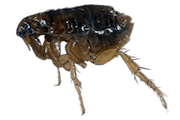Flea Extermination to Keep Your Family & Pets Healthy

Fleas are small, thin, wingless insects known for bites that produce itching, irritation and red bumps on the skin. Humans most often come in contact with fleas from dogs or animals other than cats, as cat fleas have the unique distinction of staying on their host.
Even though fleas cannot fly, they have long, powerful legs that let them jump incredibly long distances. They feed on blood, producing bites that can cause severe discomfort as well as serious health issues in pets and people.
Fleas deposit a small amount of saliva with each bite, and the saliva can cause an allergic reaction. Flea Allergy Dermatitis in dogs can result in scabs and bumps on the dog’s neck or back. Allergic reactions in people can result in intense itching, hives, rashes, shortness of breath and even swelling of hands, mouth, lips and face.
Flea bites can additionally put dogs at risk for anemia if too many fleas attack. Tapeworms can also result if your dog ingests an infected flea.
You’ll want to get rid of fleas in homes as rapidly as possible, and professional flea extermination services are the most effective way to do so.
Identifying Fleas
Adult fleas range from a reddish-brown to black color and measure between 1 and 3 mm in length. Their heads appear relatively small compared to their elongated bodies and spindly legs. Their incredibly jumping ability can make it appear as if they are flying short distances.
Flea eggs are only about .5 mm in size, with a smooth, white oval exterior. Flea larvae are translucent when they hatch, with a dark stomach visible through their skin. They are not much bigger than the eggs, reaching up to 1.5 mm in size.
The larvae spin silk cocoons in carpet fibers and other small indoor or outdoor crevices. The cocoons are sticky and often attract dirt and other debris that serve as a kind of camouflage.
Warning Signs You Have Fleas
Fleas are visible to the naked eye, and infestations can be apparent through a number of warning signs.
- Flea bites: Flea bites on humans are typically found on the lower legs, ankles and feet. You’ll notice small red spots surrounded by red halos
- Fleas on pets: When running a comb through your pet’s hair, look for fleas to hop from the exposed area back into thicker parts of the furniture
- Fleas themselves: You may also see small, reddish-brown to black specks on your pet’s underside or hopping around your carpet, drapery or furniture
- Flea cocoons: The small, silken cocoons can be another flea giveaway, although they may be coated with dirt and debris
Treatment of Fleas
It takes two flea control treatments to successfully get rid of fleas in homes, along with a few preparatory measures you need to take before flea extermination can begin. The preparatory measures need to be taken at the same time as the flea extermination to ensure all stages of the fleas are eradicated.
Prepping Your Home
- Vacuum and clean the entire area where pets roam indoors. Make sure you throw away the vacuum bag, or place the contents of a bagless vacuum in a sealed plastic bag. Fleas can hatch and breed in a vacuum you forgot to empty or clean
- Wash pet bedding in hot water. You’ll also want to wash any slipcovers, pillows or other furniture or fabrics with which your pet has been in contact
- Treat your pet’s fleas with a trip to the vet or recommended products once the flea exterminator has arrived
Flea Extermination Visits
The first flea control visit requires you, your family and pets leave the home. The first round of flea extermination is designed to kill adult and nymph fleas, treating your home’s interior, exterior and surrounding fencing if needed.
The second flea control visit is to kill the eggs that hatch after the initial flea extermination treatment. The double-treatment method breaks the life cycle of the flea and ensures all flea stages are addressed.
How You Can Prevent Future Flea Invasions
The process required to get rid of fleas in homes is intense, but you can avoid it with flea control steps that help prevent future infestations. These include:
- Using a flea prevention product for your pet as directed
- Regularly vacuuming areas your pet frequents, particularly furniture, carpeted areas and your car
- Washing your pet’s bedding, blanket, plush toys and other items in the hottest water safe for the items
- Keeping your yard neat by raking up leaves, clippings, debris and mowing your lawn
- Hanging rugs, door mats and other non-washable items in direct sunlight
Flea control starts with proper prevention steps, with one of the most important being protecting your pets from fleas wherever they may roam. Because flea infestations can quickly explode, even spreading to neighboring homes or apartments, it’s essential you get rid of fleas as soon as you notice signs of in invasion.



